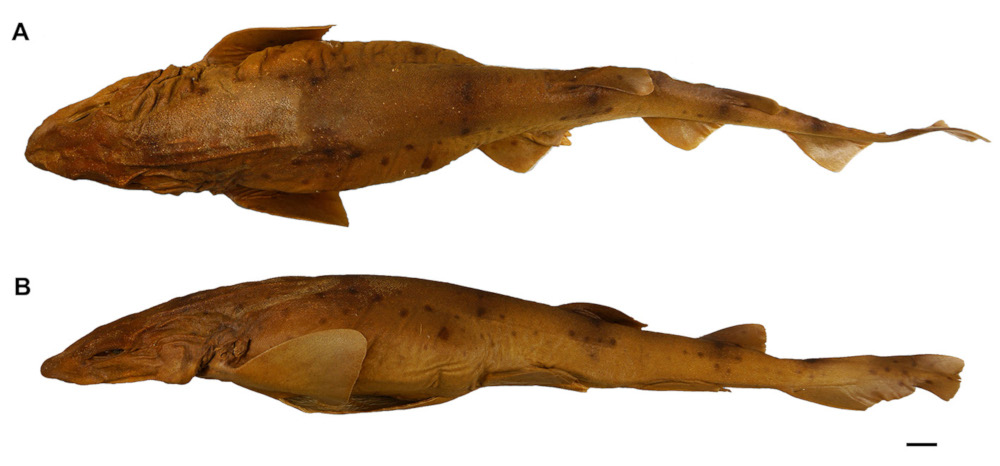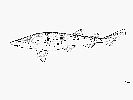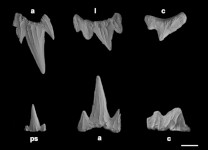Scyliorhinus cervigoni
Maurin & Bonnet, 1970
West African catshark
Classification: Elasmobranchii Carcharhiniformes Scyliorhinidae
Reference of the original description
Poissons des côtes nord-ouest africaines (Campagnes de la "Thalassa", 1962 et 1968). Revue des Travaux de l'Institut des Pêches Maritimes, 34(2): 125–170
Poissons des côtes nord-ouest africaines (Campagnes de la "Thalassa", 1962 et 1968). Revue des Travaux de l'Institut des Pêches Maritimes, 34(2): 125–170
Image of the original description
Image in copyright.
Image in copyright.
Synonyms / new combinations and misspellings
Scylliorhinus cervigoni
Scylliorhinus cervigoni
Description :
Citation: Scyliorhinus cervigoni Maurin & Bonnet, 1970: In: Database of modern sharks, rays and chimaeras, www.shark-references.com, World Wide Web electronic publication, Version 12/2025
Please send your images of "Scyliorhinus cervigoni" to info@shark-references.com

Scyliorhinus cervigoni Maurin & Bonnet, 1970, neotype, ZMH 102563, male, 623.1 mm TL (Senegal). A, dorsal view; B, lateral view Scale bar = 20 mm. © Karla A. Soares, Laboratório de Ictiologia, Departamento de Zoologia, Instituto de Biociências, Universidade de São Paulo

Scyliorhinus cervigoni Maurin & Bonnet, 1970, neotype, ZMH 102563, male, 623.1 mm TL (Senegal). A, dorsal view; B, lateral view Scale bar = 20 mm. © Karla A. Soares, Laboratório de Ictiologia, Departamento de Zoologia, Instituto de Biociências, Universidade de São Paulo
Common names
 Alitán,
Alitán,  Alitán africano,
Alitán africano,  Roussette thalassa,
Roussette thalassa,  Nurse hound,
Nurse hound,  West African cat shark,
West African cat shark,  West African catshark
West African catshark
 Alitán,
Alitán,  Alitán africano,
Alitán africano,  Roussette thalassa,
Roussette thalassa,  Nurse hound,
Nurse hound,  West African cat shark,
West African cat shark,  West African catshark
West African catshark
Short Description
Diagnosis after Compagno, 1984 [517]: Field Marks: A fairly large, very stout catshark with relatively large, few, and scattered dark spots, dark saddles centred on dark spots on the midline of the back, and no white spots, small anterior nasal flaps that barely reach mouth, no nasoral grooves, labial furrows on lower jaw only, interdorsal space slightly less than anal base, second dorsal fin much smaller than first. Diagnostic Features : Body. very stout, head broad and fairly flat, greatest width of head at least 2/3 of head length; no nasoral grooves; anterior nasal flaps not expanded and just reaching mouth. First dorsal origin slightly behind pelvic insertions; second dorsal origin over last third of pelvic bases; interdorsal space somewhat less than anal base. Denticles fairly large and erect, skin relatively rough. Colour pattern of scattered large and some small dark spots along body, 8 or 9 dusky saddle marks centred on dark spots on midback; no light spots. Size large, probably over 80 cm.
Diagnosis after Compagno, 1984 [517]: Field Marks: A fairly large, very stout catshark with relatively large, few, and scattered dark spots, dark saddles centred on dark spots on the midline of the back, and no white spots, small anterior nasal flaps that barely reach mouth, no nasoral grooves, labial furrows on lower jaw only, interdorsal space slightly less than anal base, second dorsal fin much smaller than first. Diagnostic Features : Body. very stout, head broad and fairly flat, greatest width of head at least 2/3 of head length; no nasoral grooves; anterior nasal flaps not expanded and just reaching mouth. First dorsal origin slightly behind pelvic insertions; second dorsal origin over last third of pelvic bases; interdorsal space somewhat less than anal base. Denticles fairly large and erect, skin relatively rough. Colour pattern of scattered large and some small dark spots along body, 8 or 9 dusky saddle marks centred on dark spots on midback; no light spots. Size large, probably over 80 cm.
Distribution
Southeastern Atlantic, from Arguim, Mauritania (20º31’N) to central coast of Angola (12º36’S). Positive records of occurrence exist from Senegal, Guinea Bissau, Liberia, Ghana, Nigeria, Cameroon and Gabon [27296] Source: www.gbif.org
Southeastern Atlantic, from Arguim, Mauritania (20º31’N) to central coast of Angola (12º36’S). Positive records of occurrence exist from Senegal, Guinea Bissau, Liberia, Ghana, Nigeria, Cameroon and Gabon [27296] Source: www.gbif.org
Human uses
fisheries: subsistence fisheries
fisheries: subsistence fisheries
Biology
Oviparous, paired eggs are laid. Embryos feed solely on yolk [733]. Found on rocky and muddy bottoms of the continental shelf and upper slope. Temperature: 11-16°C. Salinity: 30 ppt. Oxygen: 1.0-1.6 ml/l. Feeds on bony fishes.
Oviparous, paired eggs are laid. Embryos feed solely on yolk [733]. Found on rocky and muddy bottoms of the continental shelf and upper slope. Temperature: 11-16°C. Salinity: 30 ppt. Oxygen: 1.0-1.6 ml/l. Feeds on bony fishes.
Habitat
demersal; marine; depth range 45 - 500 m
demersal; marine; depth range 45 - 500 m
Dentition
Monognathic heterodonty gradual well developed; anterior teeth abruptly larger than the parasymphysial ones and lateral teeth smaller distally, with smaller and thicker principal cusps (Fig. 30). Sexual heterodonty not observed; only male specimens examined. Tooth counts 21–29 23–29/20–26 21–27. Parasymphysial teeth with a principal cusp flanked by one cusplet on each side; cusplets 1/3 the height of the principal cusp and half the width of it. Protuberances present on the crown base and striae running from the crown base to the apex of the principal cusp. Anterior teeth similar in shape to parasymphysial ones; principal cusp four times higher than cusplets. Protuberances in crown base poorly developed and striae throughout the crown. Lateral teeth with three cusplets; two at the mesial edge and one at the distal edge. Lateral upper teeth with proximal mesial and distal cusplets larger and corresponding to half the height of the principal cusp and median portion of root more concave; lower teeth with cusplets smaller and concavity of root less prominent. Principal cusp slightly oblique in both jaws. Protuberances present in the crown base and striae extending throughout the crown. Commissural teeth with one cusplet and principal cusp stronger, slightly oblique and laterally situated. Protuberances well prominent and striae extending throughout the crown. Ectodermal pits present in lateral and commissural teeth, restricted to the crown base.[27296]
Monognathic heterodonty gradual well developed; anterior teeth abruptly larger than the parasymphysial ones and lateral teeth smaller distally, with smaller and thicker principal cusps (Fig. 30). Sexual heterodonty not observed; only male specimens examined. Tooth counts 21–29 23–29/20–26 21–27. Parasymphysial teeth with a principal cusp flanked by one cusplet on each side; cusplets 1/3 the height of the principal cusp and half the width of it. Protuberances present on the crown base and striae running from the crown base to the apex of the principal cusp. Anterior teeth similar in shape to parasymphysial ones; principal cusp four times higher than cusplets. Protuberances in crown base poorly developed and striae throughout the crown. Lateral teeth with three cusplets; two at the mesial edge and one at the distal edge. Lateral upper teeth with proximal mesial and distal cusplets larger and corresponding to half the height of the principal cusp and median portion of root more concave; lower teeth with cusplets smaller and concavity of root less prominent. Principal cusp slightly oblique in both jaws. Protuberances present in the crown base and striae extending throughout the crown. Commissural teeth with one cusplet and principal cusp stronger, slightly oblique and laterally situated. Protuberances well prominent and striae extending throughout the crown. Ectodermal pits present in lateral and commissural teeth, restricted to the crown base.[27296]
Remarks
shark-references Species-ID=6303;
shark-references Species-ID=6303;




















